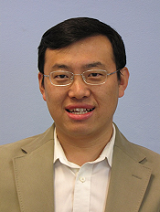Topic:Blind Interference Alignment with Diversity
Time:2014年12月18日(周四)上午11:00-12:00
Venue:信电大楼, 215学术会议室
Speaker:Wei Zhang, Associate Professor,
IEEE Fellow, School of EET,
The University of New South Wales,
Sydney, Australia
Biography
Wei Zhang received the PhD degree in EE from the Chinese University of Hong Kong in 2005. He was Research Fellow at the Department of Electronic and Computer Engineering, Hong Kong University of Science and Technology (HKUST) in 2006-2007. In 2008, he joined the School of Electrical Engineering and Telecommunications, The University of New South Wales, Sydney, Australia, where he is currently Associate Professor. His current research interests include cognitive radio, energy harvesting communications, MIMO, and multiuser information theory. He received the best paper award at the 50th IEEE Global Communications Conference (GLOBECOM), Washington DC in 2007 and the IEEE Communications Society Asia-Pacific Outstanding Young Researcher Award in 2009. He is an Editor of IEEE Transactions on Wireless Communications and an Editor of IEEE Journal on Selected Areas in Communications (Cognitive Radio Series). He served as a TPC Co-Chair of Communications Theory Symposium of IEEE ICC 2011 and a TPC Co-Chair of Wireless Communications Symposium of IEEE ICCC 2013. He was TPC Chair of Cognitive Radio Symposium of the IEEE GlobalSIP 2014. He was elevated to IEEE Fellow in November 2014 for his contributions to cognitive radio communications. He was elected as Secretary of IEEE Wireless Communications Technical Committee in December 2014.
Abstract
Interference alignment has been recently studied as an effective tool to achieve degree of freedom (DoF) of wireless interference channels. DoF is also known as multiplexing gain or capacity pre-log scaling factor and provides a capacity approximation of wireless network in the high signal-to-noise ratio region. However, the interference alignment technique requires precoder design with the channel state information at transmitters (CSIT) so that the interferences can be aligned at receivers. Blind interference alignment can overcome the limitation of full CSIT by adopting pattern reconfigurable antennas at receivers. In this talk, the wireless interference channel is investigated from a different perspective and the diversity benefits of wireless interference channels are explored. A space-time coding approach is designed to achieve high diversity gain and high rate for MISO interference channels with reconfigurable receiver antennas. A family of diversity achieving techniques is proposed with blind interference alignment to accommodate various needs of diversity-rate tradeoff.







 您的位置 :
您的位置 : 